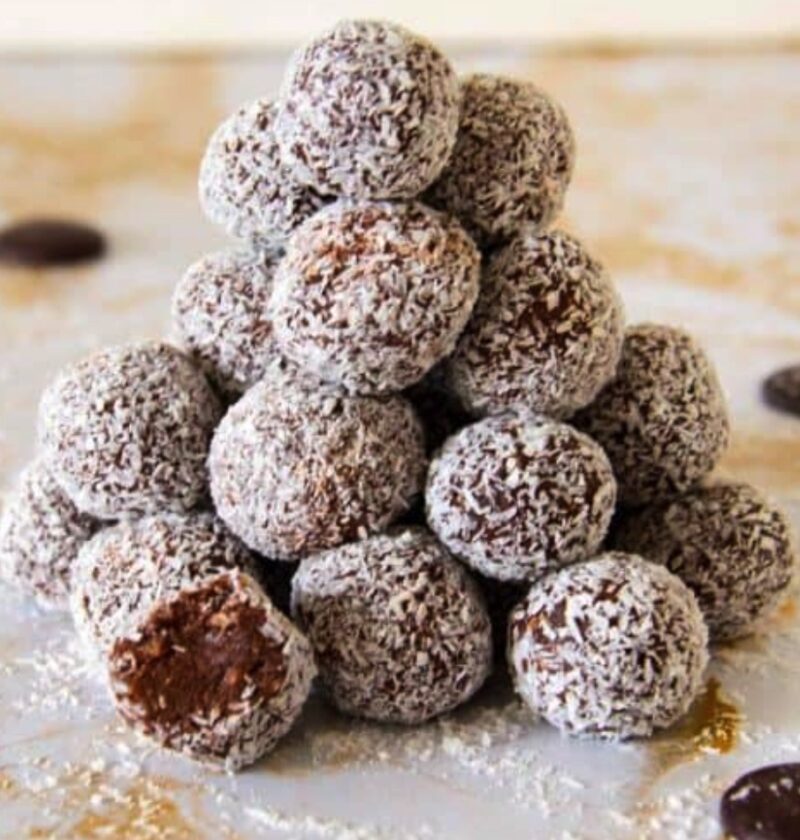
Who can resist chocolate’s allure? And the temptation is simply too great when it comes to chocolate truffles. These delicious bite-sized confections are a symphony of rich and creamy soften-in-your-mouth chocolate that have been beautifully made. Chocolate truffles are an indulgence that you just must try if you have a sweet cravings or are a chocoholic. You won’t be able to stop eating them. Thus, get ready to be enchanted by the rich world of chocolate truffles! Our recipe will help cure those cravings with easy steps and ingredients. This chocolate truffle recipe is certain to catch your eye and have you hungry for more. So gather your ingredients, wear your apron, and get ready to savor the finest chocolatey goodness!
Ingredients
Instructions
- Cream should steam when heated in a pot. Pour hot cream over chocolate in a bowl, then whisk the mixture until the chocolate has melted and combined with the cream.
- One to two hours are needed to chill until completely solid. To avoid the ganache from melting or clinging to your hands, scoop up about a tablespoon of it and rapidly roll it into a ball using latex gloves. Line more truffles on a plate or baking sheet, then repeat.
- Place truffles in the freezer or refrigerator for a few minutes if they become too soft to handle. They can be coated in confectioners' sugar, cocoa powder, or sugar and cinnamon. Serve right away or keep in the fridge for up to four days wrapped in plastic.
Notes
Barringer , S. https://news.osu.edu/the-fascinating-chemistry-of-chocolate/(accessed 2023-04-12) The fascinating chemistry of chocolate. This source presents the ideology of science in chocolate. Professor Sheryl Barringer is a professor in Food Science and Technology at Ohio State University. Professor Barringer discusses the complexity in creating delicious chocolate. Carbon, hydrogen, and oxygen are all present in the intricate blend of organic chemicals that make up chocolate. Iron, calcium, magnesium, and other elements are also present in trace levels. The two primary ingredients in chocolate are cocoa butter and cocoa solids, both of which are derived from cocoa beans. Alkaloids like caffeine, as well as flavonoids and phenolic compounds with antioxidant qualities, are among the many chemical substances found in cocoa solids. When creating the sweet chocolate, other ingredients such as sugar, milk, and emulsifiers are added. These ingredients can affect the chemistry of chocolate by changing the texture, flavor, and smell. Tempering, which involves heating and chilling chocolate to a set temperature, also alters its chemistry by preventing the fats from crystallizing, which changes the texture and appearance of the chocolate. Bittman, M. https://cooking.nytimes.com/recipes/1017660-chocolate-truffles/(accessed 2023-04-12) Chocolate Truffles. This source presents a recipe to create baker level chocolate truffles at home. The author and creator of this delicious recipe is Mark Bittman, who is an American food journalist that works for the New York Times. Bittman explains to his audience how creating chocolate truffles at home can be at ease. Most people are scared of the idea of creating a chocolate ganache but Bittman reassures that it is not. Bittman’s chocolate truffle recipe calls for three ingredients and three steps; that simple! The duration of this recipe is 30 minutes to make 24 chocolate truffles. Davis,C.https://www.forbes.com/sites/chelseadavis/2019/02/11/the-ultimate-guide-to-diy-chocolate-truffles/ (accessed 2023-04-12). The Ultimate Guide to DIY chocolate truffles. This source presents different techniques to use to temper the chocolate and describe different ingredients and substitutes. The author of this article is Chelsea Davis, she is a freelance writer who enjoys great food and has created a guide to best describe how to create chocolate truffles at home with basic ingredients. Her article explains how when tempering the chocolate, finely chopped chocolate should be placed in a clean, dry, metal bowl that may be used as a double boiler by setting it over a pot of hot water when tempering. Also, explains that to prevent steam from the saucepan from escaping and condensing into the chocolate, the bowl needs to be big enough. Davis also explains different techniques to temper with different types of chocolate with different temperatures. Kim, Y. J.; Kang, S.; Kim, D. H.; Kim, Y. J.; Kim, W. R.; Kim, Y. M.; Park , S. https://www.sciencedirect.com/science/article/pii/S235261811730015X (accessed 2023-04-12) Calorie reduction of chocolate ganache through substitution of whipped cream. This source presents different types of milk and uses whipped cream to compare which is healthier, can mix well in the ganache, and contains the least amount of fats. The authors mention how an experimental group received the chocolate with milk, coconut milk, and vegetable cream, while the control group received the chocolate with heavy whipping cream. In the experimental groups, milk, vegetable cream, or coconut milk were used instead of heavy whipping cream, while the other ingredients remained the same. 100 g of chocolate, 100 g of whipped cream, and 3 g of cocoa powder were used to make the chocolate ganache utilized as the control group. Overall, coconut milk contained the least fats and was most suitable for the chocolate ganache.